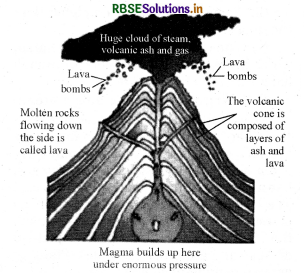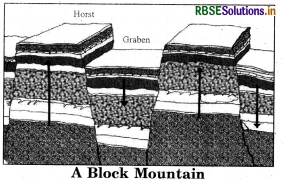RBSE Class 6 Social Science Important Questions Geography Chapter 6 Major Landforms of the Earth
Rajasthan Board RBSE Class 6 Social Science Important Questions Geography Chapter 6 Major Landforms of the Earth Important Questions and Answers.
RBSE Class 6 Social Science Important Questions Geography Chapter 6 Major Landforms of the Earth
Multiple Choice Questions
Question 1.
Sand dunes can be found in
(a) grasslands
(b) forests
(c) deserts
(d) All of these.
Answer:
(c) deserts

Question 2.
Mt. Kilimanjaro is in
(a) Japan
(b) Russia
(c) Africa
(d) India.
Answer:
(c) Africa
Question 3.
Jog falls in India are located in the state of
(a) Karnataka
(b) Andhra Pradesh
(c) Kerala
(d) None of these.
Answer:
(a) Karnataka
Question 4.
The permanently frozen rivers of ice are called
(a) ocean
(b) rivers
(c) glaciers
(d) lakes.
Answer:
(c) glaciers
Question 5.
Mountains arranged in a line are known as
(a) scale
(b) range
(c) direction
(d) None of these.
Answer:
(b) range
Fill in the blanks
Question 1.
Internal, processes lead to ................. and ................. of the earth's surface.
Answer:
uplifting, sinking
Question 2.
A huge mass of ice that moves slowly over a land is called .................
Answer:
glacier
Question 3
................. plateaus are of volcanic origin.
Answer:
Lava
Question 4.
The ................. in India is an example of
Answer:
Indo-Gangetic plains
Question 5.
The Himalayas and the Alps are examples of .................
Answer:
Young Fold Mountains.
True/False
Question 1.
The surface is being lowered by the process of deposition.
Answer:
False
Question 2.
The mountains may have a broad summit and a small base.
Answer:
False
Question 3.
Plateau has a flat-topped table land.
Answer:
True.
Question 4.
Plains provide much better conditions than mountainous area.
Answer:
True.

Match the column
|
Column A |
Column B |
|
1. Alps and Rockies are |
(a) Volcanic mountains |
|
2. Block mountains are also known |
(b) Fold mountains |
|
3. Mt. Kilimanjaro and Mt. Fujiyama |
(c) Horst mountains |
|
4. Nile Basin |
(d) China |
|
5. Yangtze Basin |
(e) Egypt |
Answer:
|
Column A |
Column B |
|
1. Alps and Rockies are |
(b) Fold mountains |
|
2. Block mountains are also known |
(c) Horst mountains |
|
3. Mt. Kilimanjaro and Mt. Fujiyama |
(a) Volcanic mountains |
|
4. Nile Basin |
(e) Egypt |
|
5. Yangtze Basin |
(d) China |
Very Short Answer Type Questions
Question 1.
Which two processes are responsible for the formation of different landforms?
Answer:
The internal and external processes are responsible for the formation of different landforms.
Question 2.
Give examples of young and old fold mountains?
Answer:
Young fold mountains Himalayas, The Alps. Old fold mountains the Aravali Range, the Ural Mountains, The Appalachians
Question 3.
Which plateau is famous for gold and diamond mining?
Answer:
The African Plateau is famous for diamond and gold mining.
Question 4.
What are the features of the young fold mountains?
Answer:
They have rugged relief and high conical shapes.
Question 5.
What do you mean by graben?
Answer:
Sub-sided or lowered part between two blocks of block mountain is called as graben.
Question 6.
What do you mean by horst?
Answer:
Raised or uplifted block of a block mountain is called as horst.
Question 7.
Name few examples of block mountains in the world.
Answer:
The Western Ghats in India and the Rhine valley and Vosges mountains in Europe.
Question 8.
Name the highest undersea mountain of the world. Where is it located?
Answer:
Mauna Kea in the Pacific Ocean with height of 10,205 metres is the highest undersea mountain of the world. It is located in Hawaii.
Question 9.
List some of the recreational activities carried out in the mountainous areas.
Answer:
Recreational activities carried out in mountainous areas are paragliding, river rafting, hang gliding, and skiing.
Question 10.
Which plateau is known as ‘the roof of the world’?
Answer:
The Plateau of Pamir is popularly known as ‘the roof of the world’.

Question 11.
Define hill.
Answer:
A hill is a land surface that rises higher than the surrounding areas.
Question 12.
Define mountain.
Answer:
A steep hills with an elevation of more than 600 metres is termed as a mountain.
Question 13.
Define deposition.
Answer:
The process of deposition of degraded materials in the lower places is called deposition.
Short Answer Type Questions
Question 1.
Describe the main features of the mountains.
Answer:
- Mountains are natural elevations of the earth's surface.
- They are higher than the surroun¬ding area.
- Some of them are even higher than the clouds.
- The climate of the mountains is harsh, which makes them less suitable for human habitation.
Question 2.
Write a short note on a plateau.
Answer:
A plateau is an elevated flat land. It is a flat-topped table land standing above the surrounding area. A plateau may have one or more sides with steep slopes. Plateaus, like mountains, may be young or old. For e.g., The Deccan plateau in India is one of the oldest plateaus. The East African Plateau, the Tibet plateau and the Western plateau of Australia are other examples. Plateaus are rich in mineral deposits.
Question 3.
Differentiate between volcanic mountains and block mountains?
Answer: Volcanic Mountains: These are cone shaped mountains which are formed by volcanic lava and gases which are thrown up by a vent in the Earth’s surface. This lava often solidifies and form mountains around the vent. For example. Kilimanjaro in Africa and Mt. Fujiyama in Japan.
Block Mountains: These are created, when large areas are broken and displaced vertically. The uplifted blocks are termed as horsts and the lowered blocks are called graben. For example Rhine valley and the Vosges mountain in Europe.
Question 4.
How are volcanic mountains formed? Draw a labelled diagram of volcanic mountain.
Answer:
When two plates push against each other, one plate may be forced under the other. In such a case, part of the forced plate may melt, creating magma and on finding a weak spot or crack on the Earth’s surface the magma pushes out through it. Volcanic mountains are formed due to this volcanic activity. Mt. Kilimanjaro in Africa and Mt. Fujiyama in Japan are examples of such mountains.

Question 5.
Show a block mountain through figure.
Answer:

Long Answer Type Questions
Question 1.
Discuss the various types of mountains with suitable examples.
Answer:
Mountains are broadly classified as:
- Fold Mountains are formed due to compressional force acting in the same direction. The rock strata get uplifted and form folds. They have uneven relief and high conical peaks. For example Himalayas in India.
- Block Mountains are formed when large areas are broken and displaced vertically. The uplifted block are termed as horsts and the lowered blocks are called graben. For example-the Rhine valley and the Vosges mountain, Europe.
- Volcanic mountains are formed due to volcanic activity. For example-Mt. Kilimanjaro in Africa and Mt. Fujiyama in Japan.

Question 2.
How are plateaus and plains important for us?
Answer:
Plateaus are important because:
- They are very rich in mineral deposits. Most of the world’s major mining areas are located in plateau region.
- Many plateau regions are suitable for cultivation. For example, the Deccan Plateau contains black soil, which is excellent for the cultivation of cotton.
- Often plateaus turn into famous tourist spots, especially where waterfalls are found on the steep slopes. For example- Sivanasamudra Falls in the Deccan Plateaus attract a lot of tourists.
- The waterfalls on these plateaus are also used for hydroelectric power. For example Jog Falls in Karnataka.
Plains are important because:
- They are the most suitable areas for human habitation.
- Abundant flat land is available for buildings, houses, cultivation, industrialisation, etc.
- Transportation facilities are developed due to easy construction of railways and roads.
- Fertile land is available for cultivation.
- These are highly densely populated regions of the world.
Question 3.
How are the landforms/natural resources being misused by humans?
Answer:
There are a number of ways in which natural resources are being misused by humans: For example:
- Construction of houses/industries on fertile land.
- Turning land into dumping ground.
- Throwing waste in water bodies thus polluting them.
- Clearing of forest leads to floods and barren land.
- No habitat for wildlife, disturbs the entire food chain.
